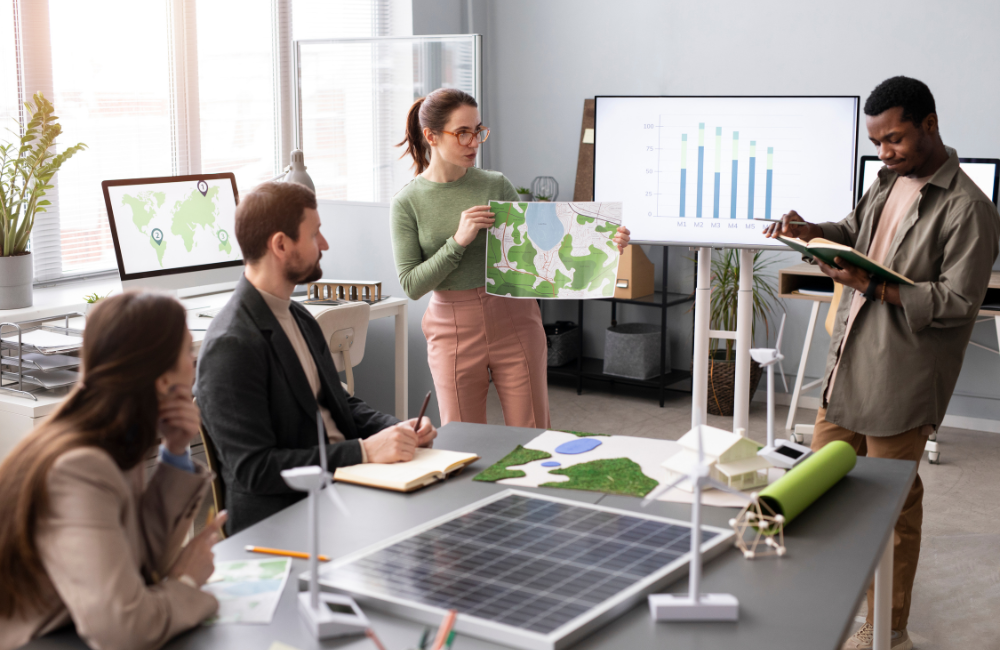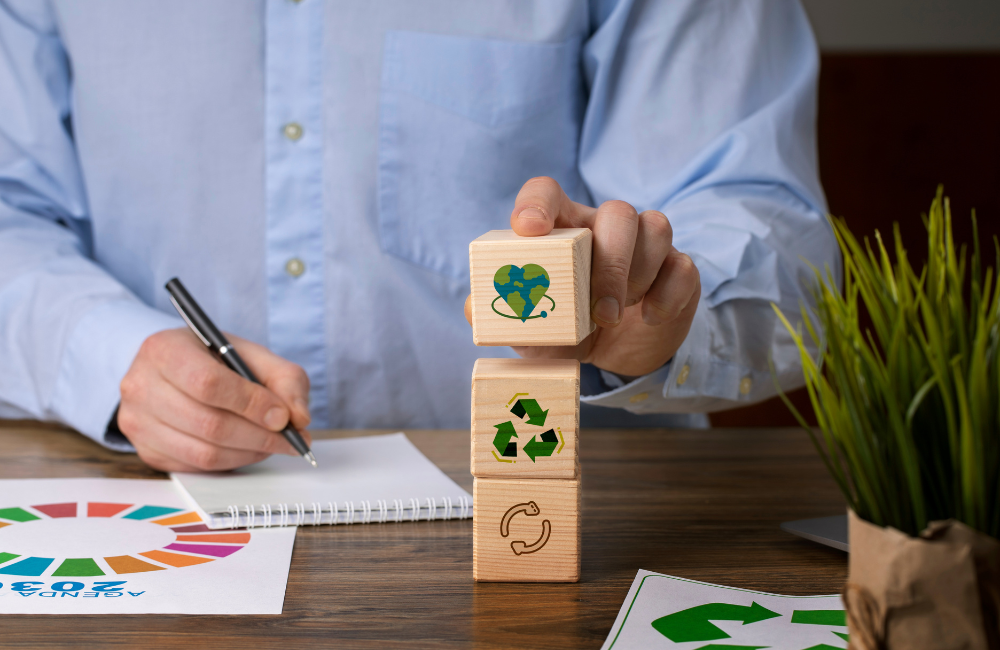
Companies today want the best of both worlds: a sustainable business model and fostering long-term success. This approach can minimize the environmental impact an organization has while promoting responsible use of resources, and positioning it as a leader! The commitment that these companies make creates enduring value since people today, as customers and employees, want to work with organizations that care about the environment.
So, what is a sustainable business model? Is it even possible to adapt this model if you aren’t a large corporation? And how does it benefit businesses of any size? Let’s find out!

What is a Sustainable Business Model?
Sustainability is about preserving resources and balancing environmental health for the long term. It’s about meeting today’s needs without sacrificing the future—a core principle of green business practices.
Beyond the basics, sustainability holds the key to unlocking business innovation and building resilience. Therefore, a business model for sustainable development generates value for everyone without draining the resources that help make it.
But the question might arise that businesses have been working well without this type of model. Why do we need it?
Well, there are several ways to approach this issue, but the most uncomplicated reason, which unites every stakeholder, is this: customers are more attracted to kind businesses. The numbers say so as well! According to a Global Buying Green report, 79% of customers are actively seeking sustainable packaging, and 82% are willing to pay for such products.
As an organization, it’s commendable to be open about sustainability goals and use it as a selling point. Consumers will question you, and the better you are at answering them, the more likely they will go tell their friends. Even if you aren’t entirely motivated by revenue and profits, you can still be driven by the need to be the change you’d like to see in the world. After all, the bigger a business becomes, the more significant its effect is on the planet and the people in it. Instead of making a switch down the line, it’s better to begin with sustainability in mind for long-term business growth.
Are you starting your own venture? Here are some excellent ideas that you can apply a sustainable business model to!

Benefits of a Sustainable Business Approach
Sustainable business models offer a wealth of benefits that go beyond profit, driving positive impact on the environment, society, and the economy. Some key advantages include:
Enhanced Brand Reputation and Image
Businesses that commit to sustainable business development enjoy a more positive and stronger brand image. This often leads to improved customer loyalty since consumers are constantly seeking companies that align with their environment and social values and responsibilities.
Cost Savings
Waste reduction, energy efficiency, and sustainable sourcing are some sustainable practices that can result in considerable cost savings. For instance, minimizing waste, using less water or energy, and optimizing supply chains can cut down on operational costs.
Risk Mitigation
Businesses oriented around sustainability are better positioned to adapt and anticipate regulatory, environmental, and social changes. This active approach helps reduce risks linked with climate change, unstable regulatory landscapes, and resource scarcity.
Enhanced Competitiveness and Innovation
Focusing on sustainability can boost innovation in services, business processes, and products. This opens up new opportunities and markets, and helps the business stay steps ahead of competitors.
Employee Retention and Attraction
Since younger generations prioritize social and environmental concerns, companies with sustainable business strategies usually attract more employees. This leads to higher employee retention levels, satisfaction, and engagement.
Positive Environmental and Social Impact
When sustainability is prioritized, businesses directly impact society and the environment in a positive way. This includes saving natural resources, decreasing greenhouse gas emissions, contributing to communities, and improving the supply chain for workers.
Lasting Business Viability
Business models for sustainable development are typically more resilient and more equipped for lasting success. These businesses are more likely to succeed in a rapidly transforming world if you consider the lasting effects of their actions and focus on long-term sustainability.
Regulatory Advantages
Companies reduce non-compliance risks and regulatory requirements when they lead in sustainability. They might benefit from subsidies or incentives for sustainable practices.

Checklist For a Sustainable Business Model Canvas
Sustainability looks different for every business. Start-ups need stakeholder buy-in, and entrepreneurs must design sustainability into their core model from the ground up. For established small businesses, sustainability usually means incremental changes that minimize disruption, allowing for gradual improvement without overhauling operations.
Therefore, before embarking on your sustainability journey, two key steps are essential:
Step 1: Audit your company
To understand where your business is at the moment, an internal sustainability audit can help. Take the time to assess your working practices and determine your carbon footprint. This will give you a clearer image of your ecological impact and what you need to change. Things to review during this audit include:
- Waste management
- Energy usage
- Resources
- Transportation
When you get a better idea of the patterns and numbers of your operational practices, you can combine them and determine the carbon footprint of your business. You can either get in touch with your local electric company or use the SME Climate Hub for calculations.
Step 2: Write a sustainable business plan
Now that you have your business’s environment footprint in focus, it’s time to map out a sustainable future by crafting a comprehensive sustainability plan is the next crucial step. A well-designed sustainability plan outlines goals, strategies, and metrics for success. Additionally, it helps you crunch the numbers to maximize ROI and impact.
Now, let’s move on to steps you can take to become one of the best sustainable business model archetypes!

Steps to Incorporate a Sustainable Business Model
Recycle Properly
Recycling isn’t just about correct trash disposal; it’s about reusing materials, conserving non-renewable resources such as plastic, and finding creative ways to repurpose production materials. Additionally, staying compliant with local regulations is a must. Assess your current recycling system and determine the areas of improvement to take your efforts to the next level.
Sustainable Packaging
It’s time to rethink your packaging if you ship products to customers. This is one of the best eco-friendly changes you can make! According to the data collated by the Organisation for Economic Co-operation and Development, more than two-thirds of plastic waste globally is caused by plastics that have a lifetime below 5 years, and 40% of this waste comes from packaging.
Pursuing sustainable product development reduces plastic waste and resource consumption for your business. Contact suppliers or manufacturers to discuss costs and sustainable substitutes.
Pro tip: Check out these methods of promoting your business without wasting too many resources.
Reduce Your Energy Usage
Lowering your energy consumption minimizes the carbon footprint for your business and saves you utility costs. And the best part? There are many ways to reduce your energy usage! Here are a few options:
- For your workplace, install LED lights and switch to energy-efficient bulbs.
- Reduce energy usage during peak demand by running heavy machinery during early morning or evening.
- Take advantage of natural light by changing the layout of your office.
- At the end of the day, power down all your machinery and equipment.
- Switch to solar panels or wind turbines, depending on your industry
Supply Chain Changes
Did you know that your company’s supply chain emissions are higher than your operational emissions? So, yes, your carbon footprint is heavily impacted by your supply chain—materials, orders, and providers can increase or lower your carbon emissions. To counter this, here are some ways to make your supply chain sustainable:
- Source local raw materials and depend less on transportation.
- Use products made from repurposed materials.
- Utilize renewable resources, such as cork or bamboo, to design products.
- Audit your suppliers to find out how ethically and sustainably they function.

Local Sourcing
Going local is a win for efficiency and sustainability. By sourcing office inventory and goods from local suppliers, businesses can lower carbon emissions from transportation. They also reduce energy consumption and enjoy faster, more reliable supply chains.
Local sourcing also has three other benefits: transparency, quality control, and community investment. By partnering with nearby suppliers, you can ensure the origin and integrity of your materials, support the local economy, and foster a positive impact that ultimately benefits your business.
Environmental Changes Beyond Your Business
Sustainability extends beyond the walls of your business. Explore ways to support ecological progress in your industry and community, and amplify your impact through partnerships, advocacy, and initiatives.
Make a tangible effort by supporting organizations driving sustainability forward. Consider regular donations or sales-based contributions to non-profits focused on environmental conservation, job creation, or innovative tech solutions.
The journey towards sustainability is a continuous process. So, keep adapting and adjusting! Regularly assess your systems, innovate, and revise to stay on track and drive lasting impact.
FAQs
1. What is the framework for sustainable business?
The framework for sustainable business involves:
- Environmental stewardship
- Social responsibility
- Economic viability
- Stakeholder engagement
- Transparency and accountability
- Constant improvement
These factors help businesses reduce their carbon footprint, promote social good, and ensure lasting success.
2. What is a sustainable business strategy?
A sustainable business strategy integrates environmental, social, and economic considerations to drive lasting value creation. It involves reducing ecological impact, promoting social responsibility, and fostering innovation.
3. What is the difference between ESG and sustainability?
Environmental, Social, and Governance (ESG) and sustainability are related, but aren’t similar. ESG refers to specific factors used to measure a company’s performance on environmental, social, and governance issues. It is usually utilized by investors to assess risk.
Sustainability, on the other hand, is a broader concept that includes a company’s overall approach to managing its environmental, social, and economic impacts. It focuses on lasting value creation.
![]()

Amilia Brown is a seasoned business writer & strategist who simplifies complex business concepts and turn them into engaging narratives. As a trusted business writer, she delivers actionable insights with precision.








